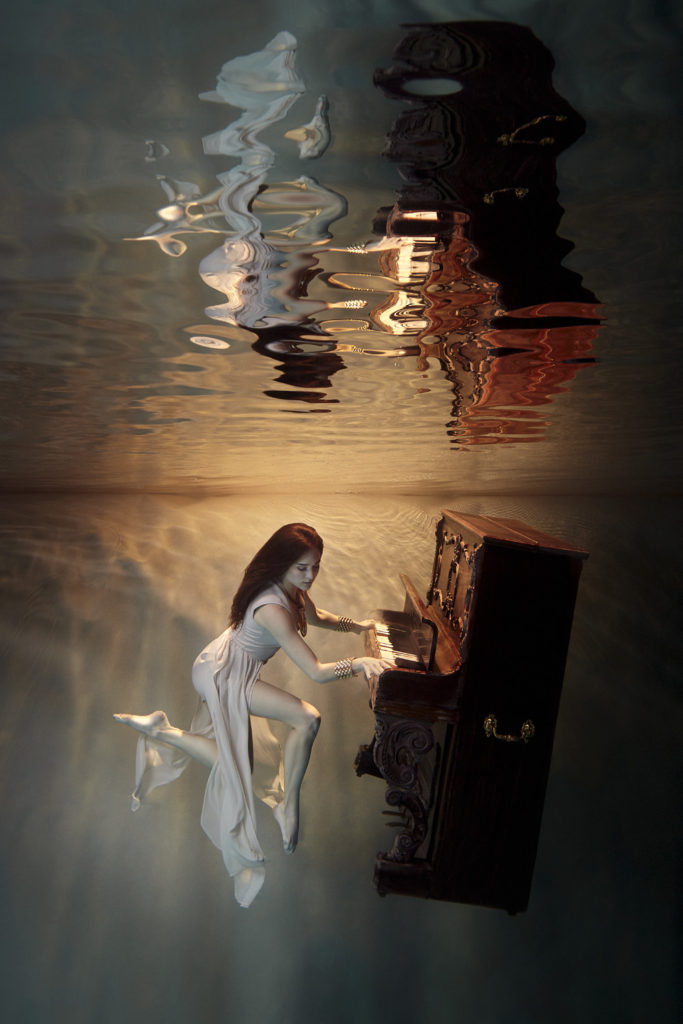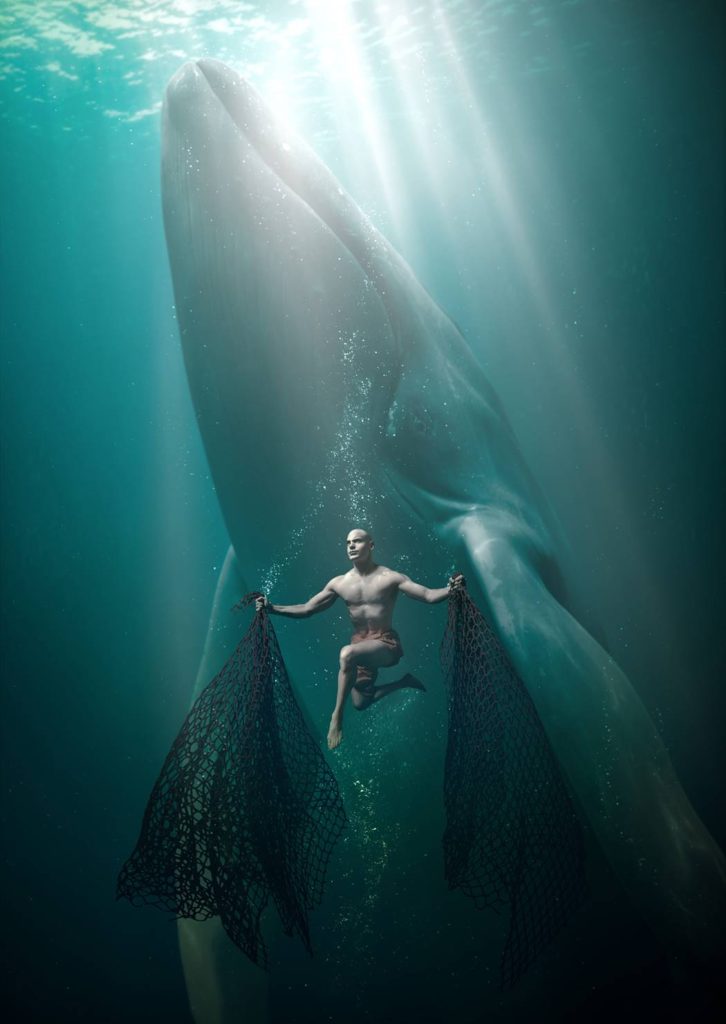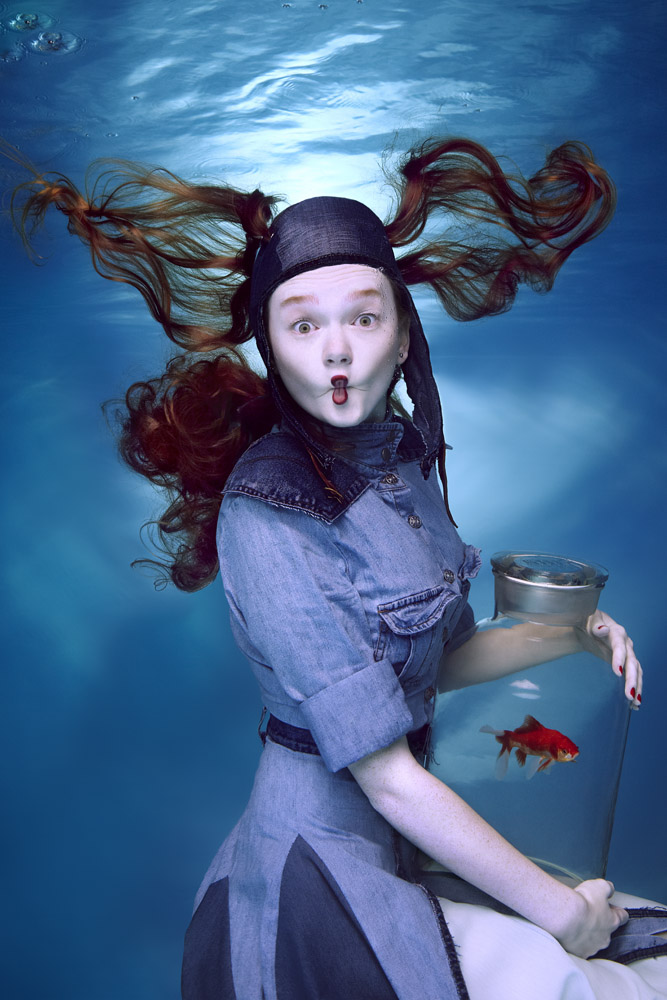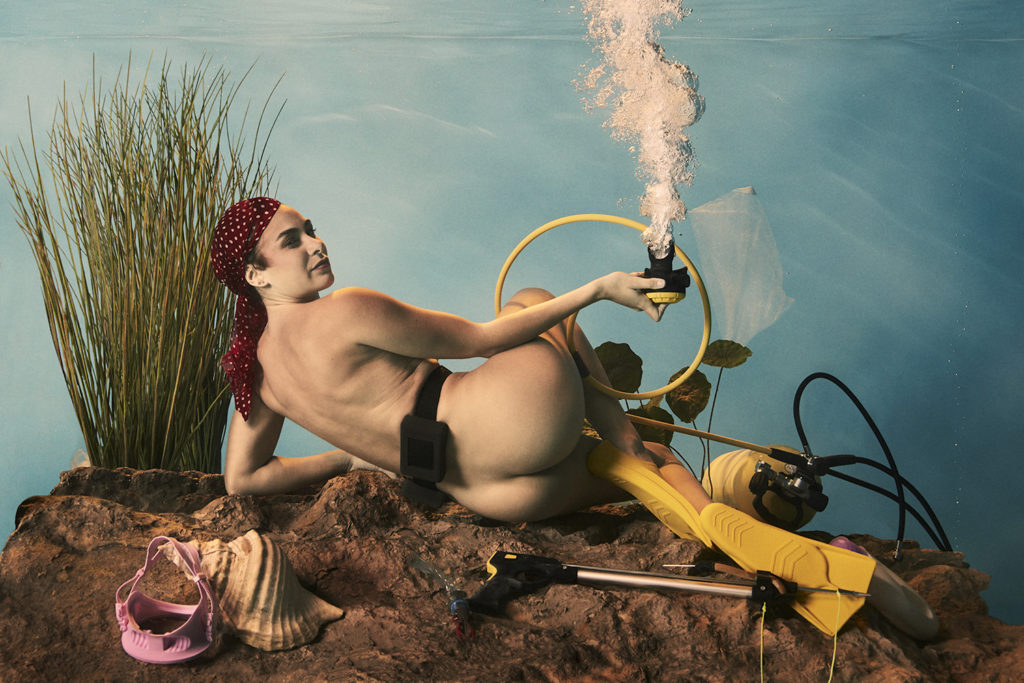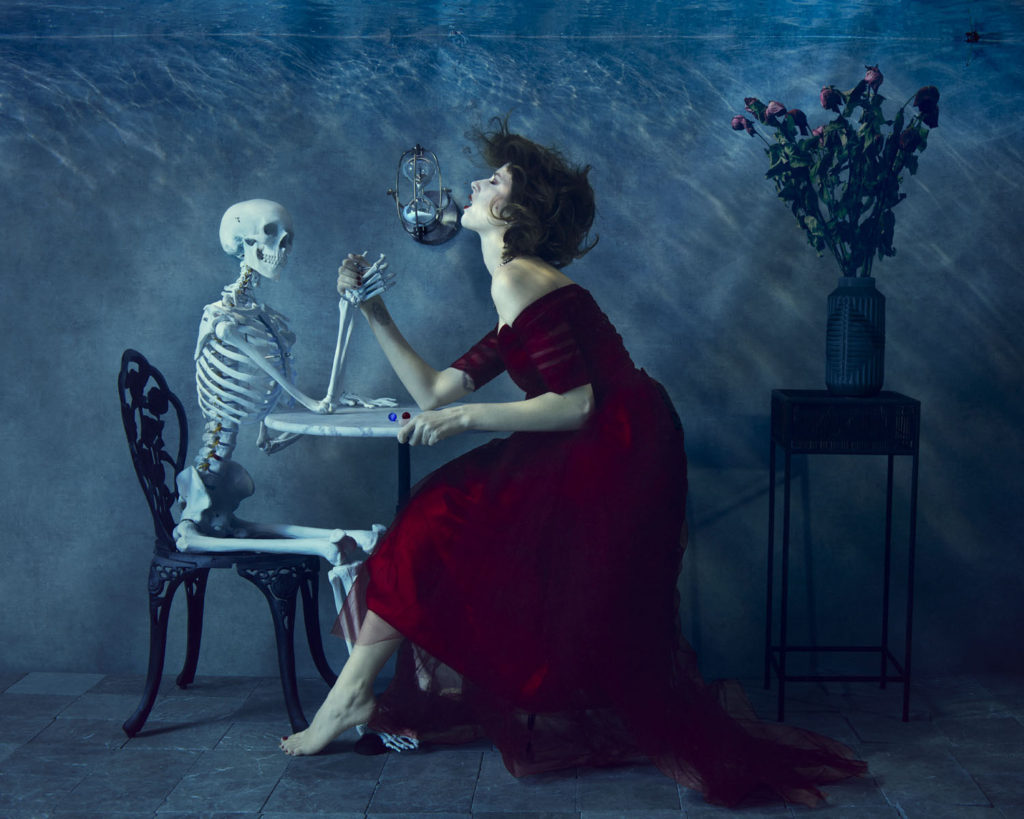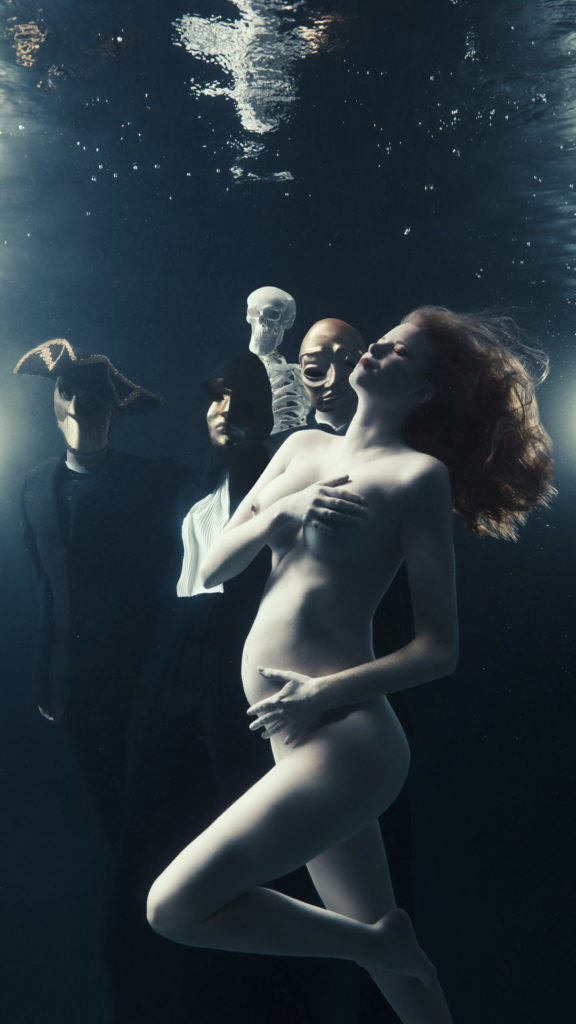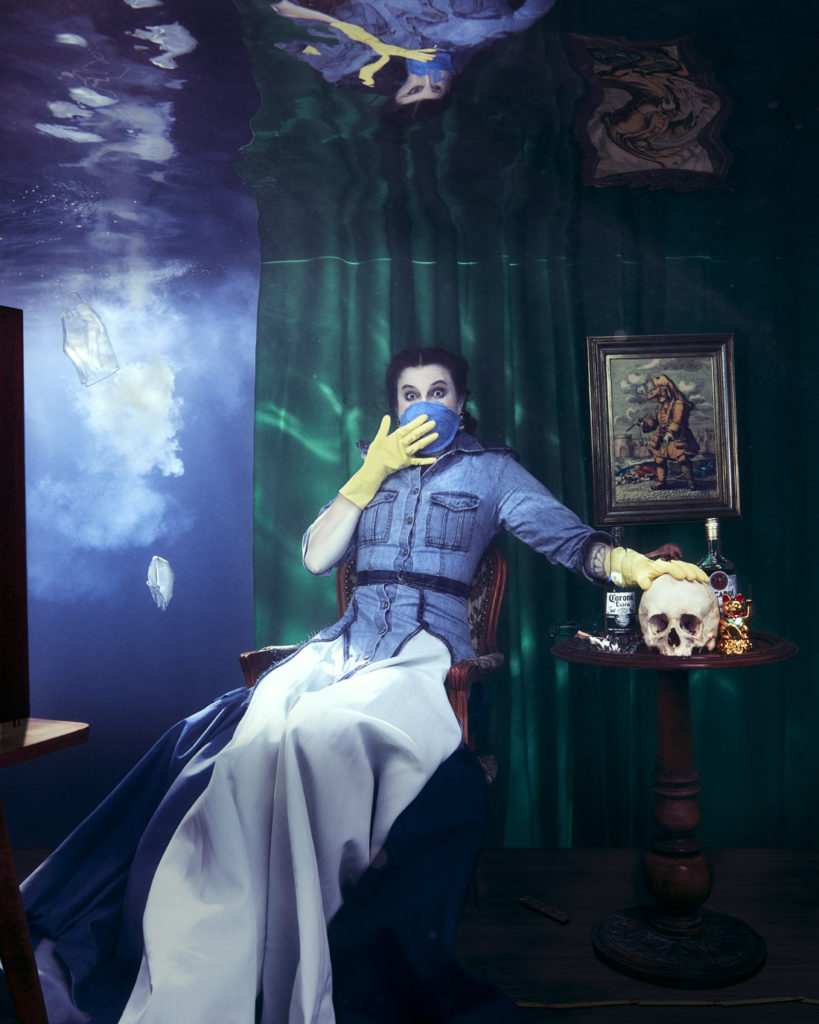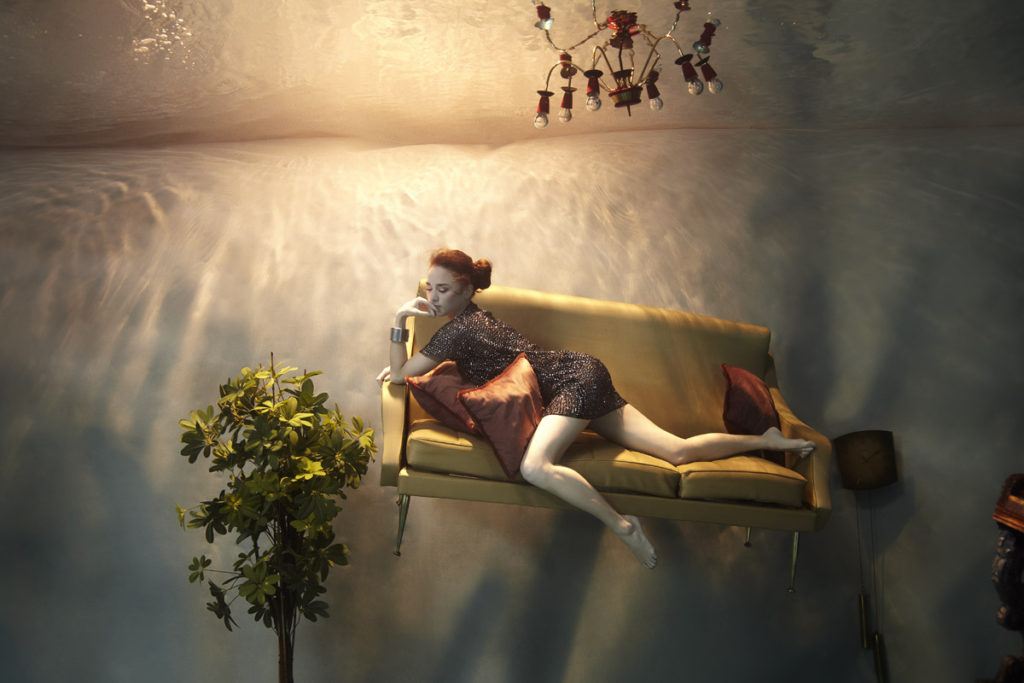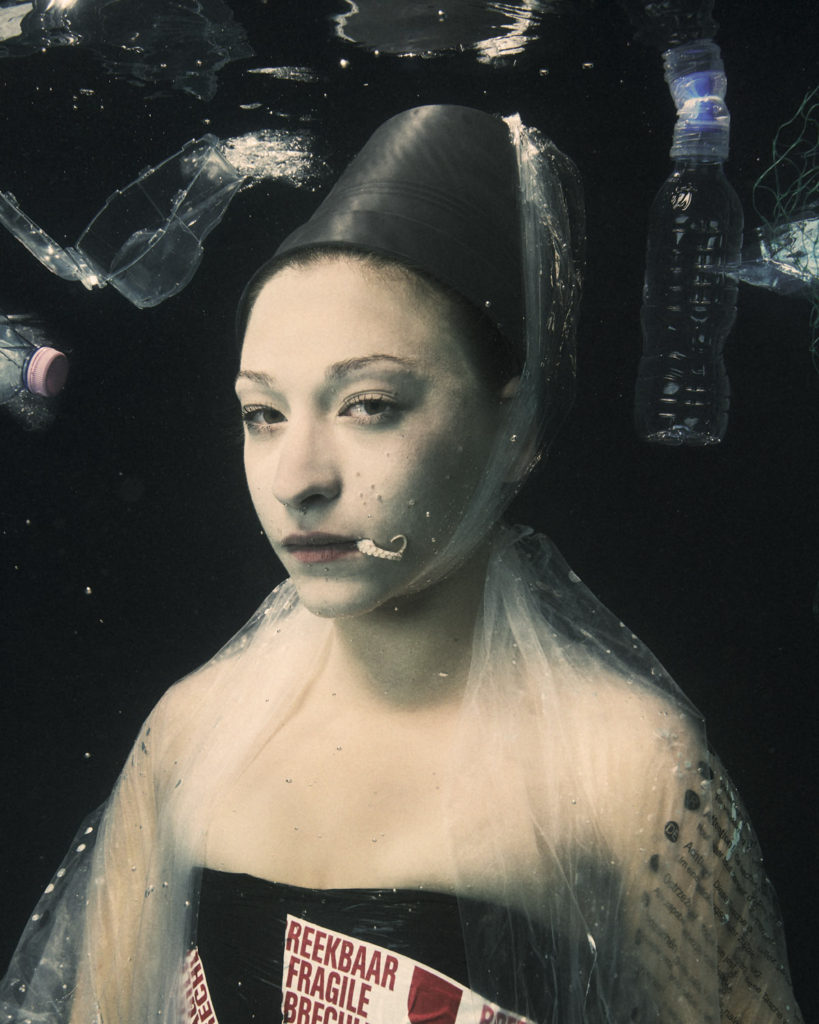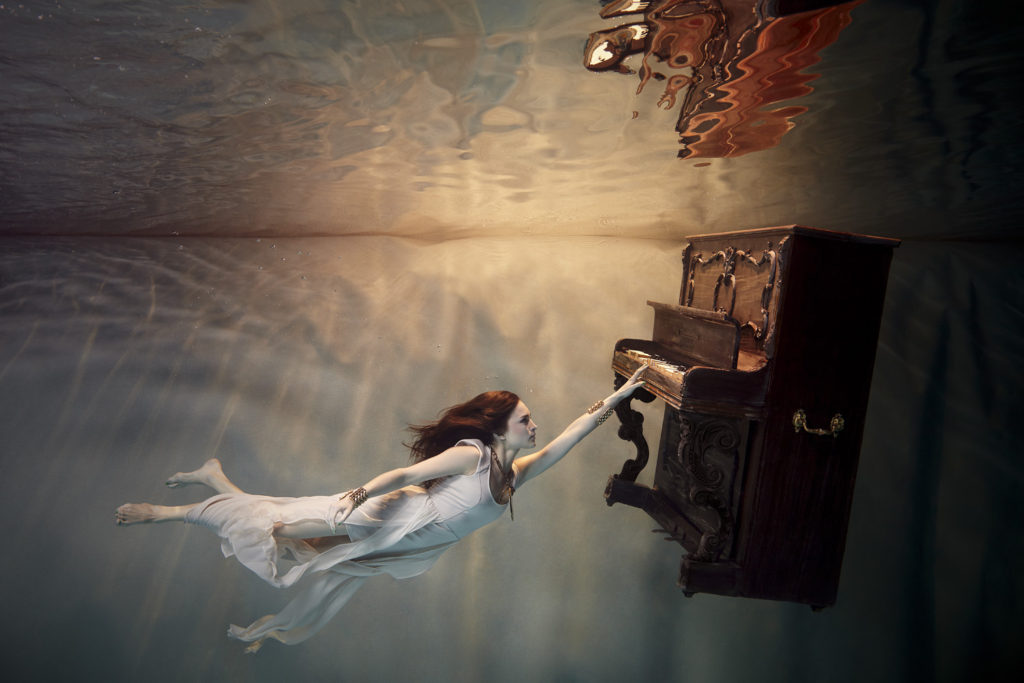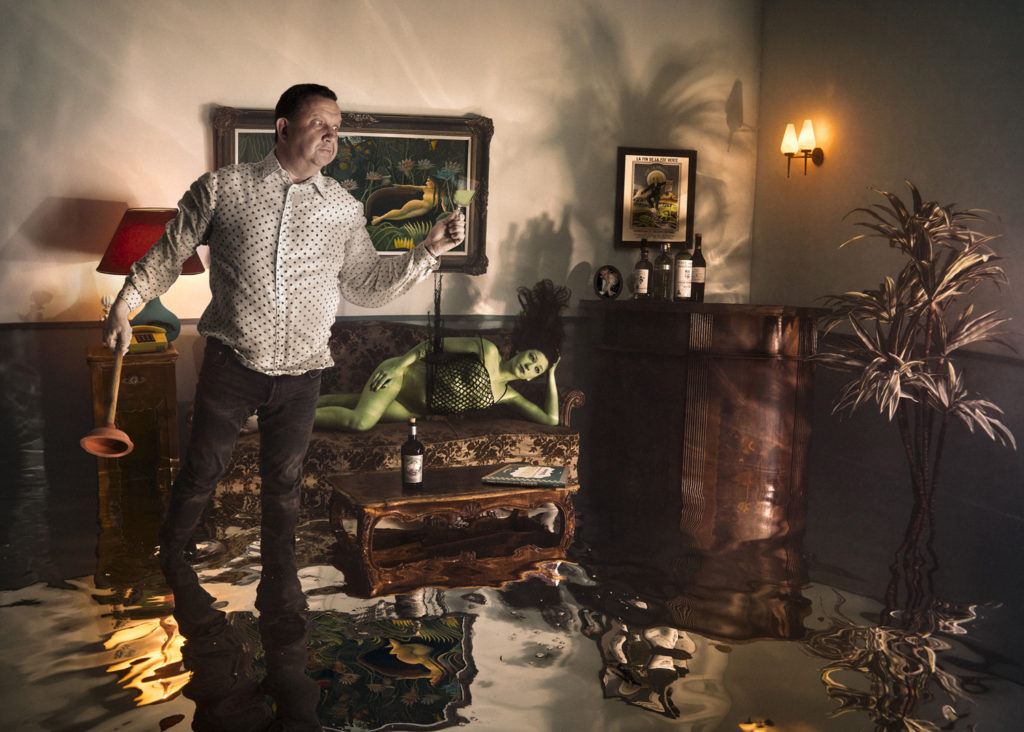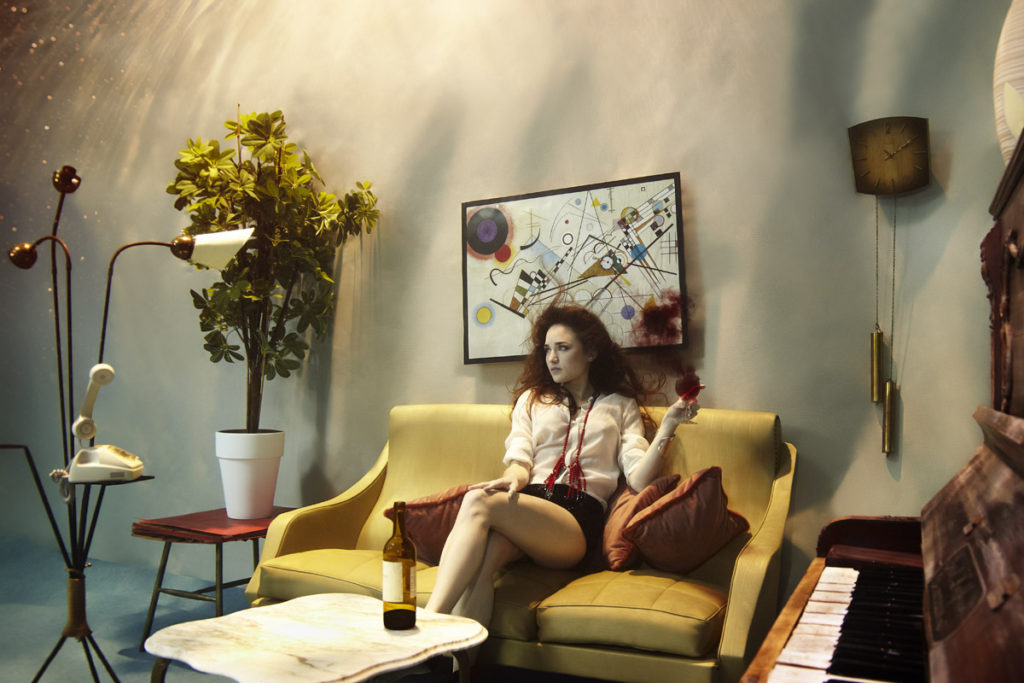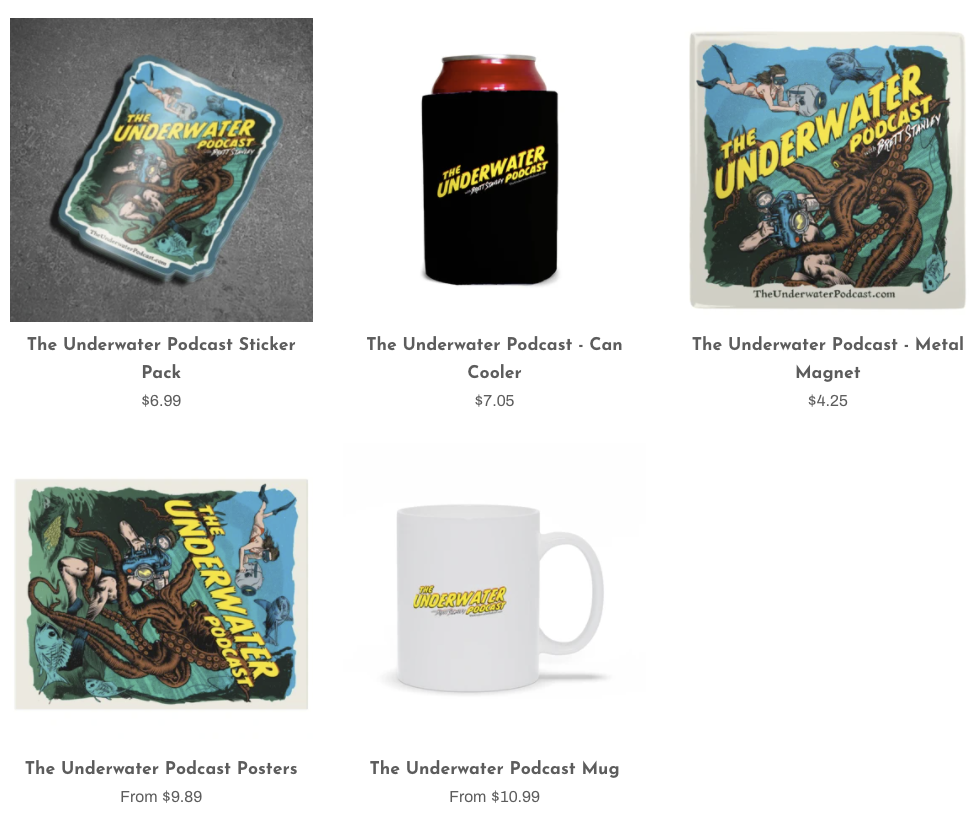Photographer Harry Fayt
In episode #45 host Brett Stanley chats with Belgian underwater photographer Harry Fayt.
Harry’s work is truly beautiful, with the worlds and concepts he creates below the surface, and his messages within each shot are very inspiring. We talk about how he creates these scenes in his local public pool, his love of cinema for inspiration, and how he’s getting his revenge after years of not being able to get in the water!
Follow this guest: Website, Instagram
Discuss the episode in our facebook group.
About Harry Fayt – Underwater Photographer
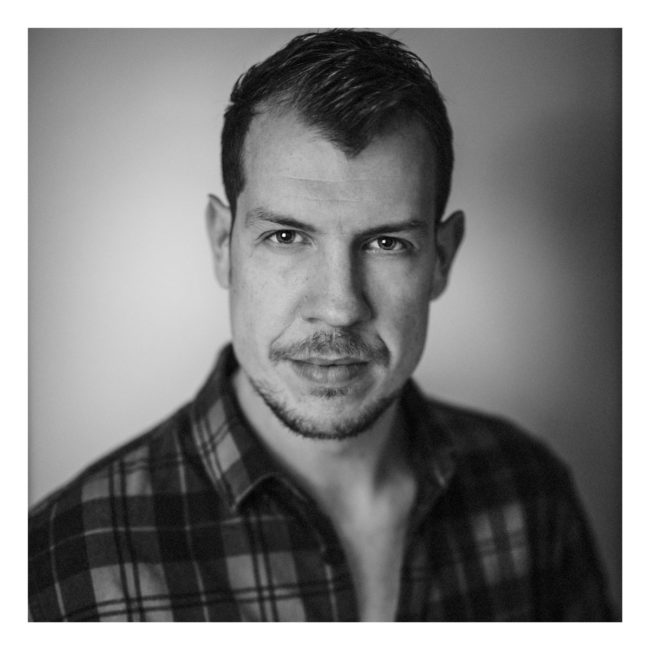
Harry Fayt was born in 1979 in Charleroi, Belgium. As far as he can remember, he has always had a special connection with water. It was however not the most suitable connection for him…
Victim of a chronic ear infection in his childhood, his treatment kept him away from pools under any circumstances. Nevertheless, stubborn and determined as a teenager can be to explore water, he developed a severe infection. A qualified doctor eventually authorized his underwater freedom.
At the age of fifteen while he was browsing through a Vogue magazine, he was fascinated by the way of bringing out the beauty in every woman. He therefore enrolled at “Félicien Rops” Technical Institute in Namur, hoping to become a fashion photographer.
In 1998, guided by his second passion, music , he wandered through Europe for years immortalizing artists for the music-related press.
In 2006, in Liège, he opened his portrait studio. Three years later, after having invested in specialized underwater photo material, he took his first swimming babies’ shots.
By merging his adolescent dream with his new studio, the pool, Harry Fayt managed to become a fashion underwater photographer.
Bored with the surface swimming, underwater peacefulness and serenity became his playground. He started to lure his preys like in a net in order to immortalize them, setting them free thereafter.
Podcast Transcript
Ep p45 – Harry Fayt
Brett Stanley: [00:00:00] Welcome back to the underwater podcast. And this week we’re talking all about props and sets underwater with Belgium photographer. Harry fate. Harry’s work is truly beautiful. With the worlds and concepts, he creates blow the surface. And his messages within each shot, uh, very inspiring.
We talk about how he creates these scenes in his local public swimming pool, his love of cinema for inspiration and how he’s getting his revenge after years of not being able to get in the water. Okay. Let’s dive in.
Harry welcome to the underwater podcast.
Harry Fayt: [00:00:33] Oh, hello, Brett. How are you?
Brett Stanley: [00:00:34] I’m good, man. I’m good. How are you? doing?
Harry Fayt: [00:00:36] Oh, it’s starting to be hot in Belgium, so it’s good
better weather here. It’s always a rain there, not enough to fill the pool. So,
Brett Stanley: [00:00:46] Oh, no. So do you, do you tend to shoot outside in swimming pools? Are you using indoor pools?
Harry Fayt: [00:00:52] Um, what’s the short should like it indoor pool, like public pool and sometime yes, outdoor, but, uh, it’s really rare
Brett Stanley: [00:01:00] Right. Yeah. Do you, do you have certain pools that you, that you stick with or do you kind of have to keep shuffling around?
Harry Fayt: [00:01:06] in Belgium. What I’m looking for. Mostly, I always need like a certain. No certain depths of, uh, I don’t know you say that in, in English,
Brett Stanley: [00:01:16] Yeah. Depth of the, poem. yeah,
Harry Fayt: [00:01:18] yeah, the put I use is three or 60, uh matter.
Brett Stanley: [00:01:22] deep. Yeah.
Harry Fayt: [00:01:24] Yes. And, uh, so I use mostly pubic pool, so I have to rent all the pool when it’s closed. So I often walk on Sunday
Brett Stanley: [00:01:32] Right.
Harry Fayt: [00:01:33] so I can have a, like a, a fair price and, uh, yeah,
Brett Stanley: [00:01:37] Yeah. Yeah. Totally. And so, uh, how often are you shooting? Like, are you, are you shooting all the time for clients or are you kind of just working for yourself and building your, your, your fine art?
Harry Fayt: [00:01:48] Uh, actually I’m, uh, I have a certain pride to be living of my art. And I’m oddly walking on my, nearly on your walking on my artwork. So sometime I do have some advertising, uh, and sometime I shoot like pregnancy and the water, but, uh, it’s really hard to, and sometimes while you private assignment for clients, like I already shoot for a family with seven people.
It was really like a huge set. And, uh, and I really liked the kind of project, uh, and about the frequency, I would say it’s unfortunately once a month, but then you always have a lot of things to prepare and. And this year has been a little bit, uh, different with COVID of course. And, uh, so I shot last Sunday, actually.
I didn’t do anything things that January
Brett Stanley: [00:02:41] Oh, wow. Okay.
Harry Fayt: [00:02:42] for personal reasons, like in, in two weeks I’d be daddy.
Brett Stanley: [00:02:47] Oh, nice. Congratulations.
Harry Fayt: [00:02:48] So yes, it’s sorts of change a little bit of the priority, but as it’s my work, you know, I asked my wife, yeah, please, please let me walk. Let me work.
Brett Stanley: [00:02:58] Totally. That’s great that you’re able to, to kind of survive on, on just living on your art, especially when it’s such a niche, kind of art is underwater that’s that’s
Harry Fayt: [00:03:07] Yeah. Yeah. But with up with up and down, and sometimes it’s really cool and sometime it’s, uh, I’m happy that I’m getting the teacher and
Brett Stanley: [00:03:16] Yeah,
Harry Fayt: [00:03:17] she bring back in the morning.
Brett Stanley: [00:03:19] That’s right. And so with your art, uh, what is your kind of main kind of revenue stream? Is, is it through selling prints and because you have a book as well, right?
Harry Fayt: [00:03:28] Yes. Um, oh yes. It’s mostly when I set my artists through gallery or through my website and, uh, one having a book was, uh, like I went to a photo once and a guy told me he was running a printing company. You told me yes. You know, Harry, there is the photograph. He doesn’t have a book and the photograph who doesn’t have a book.
Brett Stanley: [00:03:54] Right.
Harry Fayt: [00:03:55] And so I guess I should have a book. So I, uh, he did publish my book and, uh, and I just kind of a kick-ass campaign, you know,
Brett Stanley: [00:04:09] Yeah.
right now, like I’m a Kickstarter.
Harry Fayt: [00:04:12] Yes Kickstarter. And so just with this, I, I pay like main of the, of the production. So all after was just bonus because, uh, people think when they print a book, you’re going to be expensive, but you sell the book. So actually you’re making one year or so. And so I, now every photograph than I could I meet, who would like searching for someone to publish a book, I said, yeah, but why don’t you do it yourself?
Brett Stanley: [00:04:37] Yeah, exactly. Especially with the Kickstarter sort of situation, because you, you don’t even produce the book until it’s paid for, right?
Harry Fayt: [00:04:43] Yes, exactly. And give you exposure. And, uh, and then you need to be a little bit sneaky or so with the printing industry need to find deal and
Brett Stanley: [00:04:53] Yeah.
Harry Fayt: [00:04:53] they always search for publicity. So
Brett Stanley: [00:04:56] Oh, okay. So you kind of partnered with, with a printing company to,
Harry Fayt: [00:05:00] you need to be creative. You need to be creative.
Brett Stanley: [00:05:02] Oh, cool. How, how big was the run? How many issues? How many books did
Harry Fayt: [00:05:07] It was a small one. It was a small one. Uh, I did the 500 copies
Brett Stanley: [00:05:12] Okay.
Harry Fayt: [00:05:13] of this forest book and I really wanted it like, um, experimentation book.
Brett Stanley: [00:05:19] Right.
Harry Fayt: [00:05:20] So it’s open like a triptych. So you have a, like a frame, like a hole in the, in the cover and you hoping like a triptych.
It’s a math paper, really. Like, I really wanted, I wanted the book to have, um, uh, do it yourself.
Brett Stanley: [00:05:35] Right. Yeah, yeah. Like you’d made it yourself.
Harry Fayt: [00:05:37] Yeah. the bending is done with blue line, and we have a lot of different detail. And yet I’m kind of proud of this book. It was a first achievement. And now I hope that I can really use a, another one where the more complete, because this one was only about the minute photography.
I didn’t have any texts, but people are asking me about my photography more complex with the decor and atmosphere and
Brett Stanley: [00:06:03] Yeah.
So when you, when you did that first book, did you act, did you purposely shoot stuff for the book or is it more of a compilation of stuff you’d already shot?
Harry Fayt: [00:06:12] No, no, no, no, not at all. It was just my biggest copies of book all for photography. Because when I really started, like, let’s say after the water photography, uh, I did it with nudes. And so that’s why our shit like mini mini model. And I have like, uh, more than undergrad pictures. So that’s where I get the most of you made to show.
Brett Stanley: [00:06:34] Right.
Harry Fayt: [00:06:35] that’s come naturally.
Brett Stanley: [00:06:37] So the that’s interesting cause there’s, you know, there’s people that will do a book and they will set out to basically shoot all the images for that book, you know, rather than, rather than using their back catalog. But your kind of, you know, sort of creating all your work and then building the book after you’ve had such a lone career already, you’re just using everything that’s that you’ve already done.
So it’s like a
Harry Fayt: [00:06:59] Yeah. Yes, exactly. And the funny fact is that, um, there was a big, uh, photographer in Belgium back then his assistant was, um, like more like a manager was also working for to new. So it’s a bigger book company and they said, oh yeah, we should do a book together. Okay, cool. Let’s make a deal. So I kept the hand.
Okay. And then a few weeks after I said, I wanted to know about the book you do think it’s possible to have like, uh, like certain author, you know, advanced payment. So I can produce more for the book. I know. No, no, you have to pay me for the book. It’s like 10,000 euros.
Brett Stanley: [00:07:40] yeah,
Harry Fayt: [00:07:41] Okay. Okay. So it was interesting, interested to do a book with me, but it’s because she was doing all the portfolio and I don’t know what you say in English or the preparation for the book.
And she was making money from it. And when I, and another friend told me that’s a yes. When you are young photographer that you are not known, there is no publishing houses. We’re going to take the risk to publish your book. Maybe they will do it very well. Now you will have, you will back from it. And, uh, and when you see photograph or with big books yes, because they sell a lot or they already have money before, so they can afford it.
But
Brett Stanley: [00:08:19] yeah. it’s quite hard starting out.
Harry Fayt: [00:08:22] yeah. That’s how I come. My head said, yeah, I’m going to do it by myself. And I did the new regrets.
Brett Stanley: [00:08:28] That’s good. Yeah. Cause there’s so many ways to to self publish stuff. These days, you know, there’s online systems, there’s there’s um, templates and stuff you can use. It’s it’s, it’s a way easier than it was like 10, 15 years.
Harry Fayt: [00:08:40] Yeah. I think in a, in many ways it’s really more difficult to be a photographer now than a like 50 years ago because of the digital, the competition and everything. But you know how the hand is so easier to get, to get you out there with a promotion. You have internet, you have Facebook, you have Instagram, you can publish yourself of your book for not a lot of money.
So it’s kind of a paradox that it’s easy to make your advertising, but it’s not easy to live from your work.
Brett Stanley: [00:09:12] Oh, absolutely. Yeah.
because the, the, the inherent cost or the inherent value of photography these days is so low because everyone can kind of do it.
So how did you, how did you market your book when you, when you first decided to do it, how were you getting the word out there? How were you saying.
Harry Fayt: [00:09:26] I live here. I didn’t do much effort because as I say, from the, from the crowdfunding, I get like nearly all the cost covered. And then I get my, I get exhibition and mostly I assaulted to my exhibitions, my different show
Brett Stanley: [00:09:45] Yep.
Harry Fayt: [00:09:45] and I sold it now on my website. Uh, last week I have one book who’s gone, like for Spain,
Brett Stanley: [00:09:53] Oh, cool.
Harry Fayt: [00:09:54] some book like this will not region.
Uh, yeah. So it’s going all over the world. The know how the people find me, man. I’m always proud. I did I say, Hey honey, to my wife. Yeah. So the book too, no way today. Do you realize the book you paid the book? Like 105 euros, so
Brett Stanley: [00:10:13] That
Harry Fayt: [00:10:13] of a,
Brett Stanley: [00:10:14] really nice. Isn’t it? Like, it really does kind of make you feel good about stuff when someone across the other side of the
Harry Fayt: [00:10:18] If it just little things you sell a book and yeah, you’re just proud because someone on the other side of the world, just buy your book and pay 40 Euro for the, for the shipping.
Brett Stanley: [00:10:29] Yeah,
Harry Fayt: [00:10:29] You must really like it. Cool.
Brett Stanley: [00:10:31] And they’re not your family, like they’re not related to you in any way.
Harry Fayt: [00:10:34] No, my family got it for free.
Brett Stanley: [00:10:36] Yeah,
Harry Fayt: [00:10:36] a new friends do. And I have a lot of friends who are helping me. So it’s also a book it’s important to know is really like a business card that you meet. Someone, you meet a gallery up, you give a book, you meet like maybe a future prospective client.
You give a book, you, you get someone who asks you to, to get the furniture to put in the water. You’ll give a book. And
Brett Stanley: [00:10:59] Yeah.
Harry Fayt: [00:10:59] so it’s really like a morning.
Brett Stanley: [00:11:02] outside leads. It’s like it’s investing in your own in your own future career. Really? Isn’t it like it’s, it’s, it’s advertising yourself to
Harry Fayt: [00:11:08] Yeah, it’s really living, living a trace that a go, you never know where the book is going. It’s like you give a book to someone and then you get a guess at this place and you show the book and say, oh, well, what is it? They start looking and we know it can be a client or
someone who’s going to lead you somewhere.
So never underestimate the power of the book.
Brett Stanley: [00:11:31] No. Yeah, because if people leave them on their coffee tables, you know, they might be in the doctor’s office or something, you know, it it’s, it’s great. It’s just another way of getting exposed. So let’s talk about your, your more recent work, which I think is your modern icons kind of work. And I have to say, man, like, this is the work that you’ve done with the sets and with all the props and it’s, it’s so involved.
and from, from where I come from, which is, you know, building sets and stuff, underwater myself, you know, I have such a love of this work. It’s so beautiful. And so clever.
Harry Fayt: [00:12:02] Thank you. When I see your says, oh, teeth, I would like to have my, pull it to do the stuff like this. Like you do, because it’s yeah. It’s really like a, oh, you call it your magic room.
Brett Stanley: [00:12:15] Yeah.
exactly. It’s the studio, but that’s where it kind of amazes me about your stuff is that you’re doing this in the public swimming pool, you know, like it’s, it must be a lot of preparation. A lot of
must go into.
Harry Fayt: [00:12:28] Yeah, yeah. Yeah. It’s a really long time because what people done then it’s like, when I do like a martini tea pregnancy in the water, I ask a certain price. And most of the time the clients say, oh yeah, it’s expensive. I’m sorry too much for me. But they don’t realize the work that you need because you need to prepare all the work or the year.
They call the . There is one you need to put on in your car. It’s already a, like a taste to put everything in the car. It can take a long time. Then you should. If it’s more than one hour, just to put the, to take the stuff out of the car, to go to the pool, because the pool of course is at the first floor and you need to work like at least 50 meters to get there.
Then you need to open all the tripod, the prepare, everything. It’s the hour. Then you have the shoot and then at the end, you need to do all this back, but everything is wet. So once you have to open everything to let dressing then to clean stuff, and yes, it’s really, I think is the most exhausting.
Brett Stanley: [00:13:36] Yeah.
Harry Fayt: [00:13:37] because, uh, when I rent a public pool, the pool is, or per like till one, but the last day it was open there, the private sports team, I can have only the pool at 3:00 PM.
Brett Stanley: [00:13:50] Right.
Harry Fayt: [00:13:50] we start to shoot at six and I wasn’t home at four in the morning,
Brett Stanley: [00:13:55] Oh, wow.
Harry Fayt: [00:13:56] if not even the worst one day for the client. And I show it for you that we should like seven people. It was a 26 hour, like from the day I found, when I wake up to, when I, I went to sleep because it was a huge you’d set and, and I can not leave the set there and say, oh, I had checked this tomorrow.
Or we came tomorrow at six in the morning, you have the, um, the guy from the swimming pool is coming and
Brett Stanley: [00:14:23] Yeah. Yeah. You
Harry Fayt: [00:14:24] has to be,
Brett Stanley: [00:14:25] team coming
Harry Fayt: [00:14:26] to be clean
Brett Stanley: [00:14:27] yeah,
Harry Fayt: [00:14:27] you leave and when you, when you leave the pool, uh, like, uh, three in the morning and you use the, I don’t know, you already had the problem, like the velvet, the water, all the chair, like a, let’s say green velvet green, you put it in the water.
And then it’s like a bag of tea. You
order
Brett Stanley: [00:14:49] heavy and
Harry Fayt: [00:14:49] tint or the tint of the
Brett Stanley: [00:14:52] yeah.
Harry Fayt: [00:14:53] or the pool, like the pubic police or green.
Brett Stanley: [00:14:56] No.
Harry Fayt: [00:14:57] And you say, oh gee, they want me again in this poor shit.
Brett Stanley: [00:15:03] Yeah.
Harry Fayt: [00:15:04] Of course
Brett Stanley: [00:15:07] Yeah.
Harry Fayt: [00:15:08] the guy told me at five in the morning it was, it was clean, but
Brett Stanley: [00:15:12] that’s still, it’s, it’s a risk, right? Like you had you risk even just ruining your own photos because you’re putting stuff in the water that then it’s going to ruin the water quality.
Harry Fayt: [00:15:21] Yeah, it must, since I find some, uh, some trick to not get this color thinking,
Brett Stanley: [00:15:26] Oh, that’s
Harry Fayt: [00:15:27] what is it as nothing is done for underwater, you always need to be. I like to call myself my, gave her of the underwater photography,
Brett Stanley: [00:15:35] Exactly. I say
the
Harry Fayt: [00:15:37] a coloring and I sold everything.
Brett Stanley: [00:15:40] Totally. I, um, I had a shoot recently, which was a music video shoot and, W the, one of the props department, people put a carpet, a rug in the pool. Um, and within the minutes the whole pool had gone yellow and Yeah.
exactly. All the crap that was in there. And he was like, get it out, get it out, get it out.
Um, and I was like, the director was standing there and he’s like, you know what? I don’t mind that color. It’s kind of the color. I would turn the video in, in post anyway. So it kind of works. So I was like, Oh, this is
Harry Fayt: [00:16:11] Because when you are like in capture on the Lightroom, you can eat it and get, get back to the color, but it’s really the quality of the image.
Brett Stanley: [00:16:20] Yeah, exactly. So, how did you get into doing the sets underwater and the props? Was that something you’d always wanted to do? Or was it something a bit of a light bulb moment?
Harry Fayt: [00:16:29] Oh, it started, um, Hmm. Slowly. In fact, I, I come to underwater photography because I was shooting babies. I was shooting babies, uh, and, uh, and pregnancy in the studio. And I was so bored and I wanted to do something else. And as I love being in the water, I’m always searching to challenge myself. And there was talking back then to the water babies.
So I say, oh, I really want to start with, uh, with this. So I made some tests. It was a total failure.
Brett Stanley: [00:17:04] Right.
Harry Fayt: [00:17:07] We can code Brando.
Brett Stanley: [00:17:08] What’s that? Yeah. You can say brands. Yeah,
Harry Fayt: [00:17:11] yeah. yeah. Brand like, I guess, you know,
Brett Stanley: [00:17:14] Yeah. He will. Marine
Harry Fayt: [00:17:15] kind of bag. And I knew a couple of photographers who make great job about it, but I bought it like 300 euros back then. It was not working because of course I wanted to use the flush with the radio as far as meter the water, if that didn’t work. So after that, I think a little bit to my, or the process, and I got an in-studio a family who wanted to, they had to put up and I said, oh yeah, I really like it.
I would like, you can do the test at home if you want to. And they have like three really, really beautiful teenager. And so I went there and I started the test and I thought that, oh, it’s really cooler than to shoot with a teenage or adult that actually understand what you say. No, that the baby just put the baby
Brett Stanley: [00:18:00] I think that’s it.
Yeah.
Harry Fayt: [00:18:02] And, uh, and so it’s all it stops. And then it’s only two. So it was about 2008. And then in 2011, uh, I have, um, from Ukraine who contacted me and say, Hey, how are you interested to show the naked model? I did it. And it was like a revelation because it was really beautiful. And I got a, I was already into the artsy, but more like a bit like to drink your wine in the openings, if you know what I mean.
Brett Stanley: [00:18:36] Yeah, yeah,
Harry Fayt: [00:18:37] So I’m making friends and I show him my, my yummy, oh, it’s really good. Every night. Yeah, you should continue.
Brett Stanley: [00:18:42] Yep.
Harry Fayt: [00:18:43] At the point, I got a gallery in the boot in brussel was interested in my work, so they served me pretty well in the beginning. And then, uh, they told me that they would like more, they really like my news, but they don’t want to represent me on the news. They really want me to say something in my work to be more narrative
Brett Stanley: [00:19:05] Right. Yeah.
Harry Fayt: [00:19:06] is how I come first.
Who’s my, the lady in the, in the red fish, a few posts, then a big debt. No big, big moment in my small career was in 2012. When I met the singer called she’s a Belgian Tega. She was really started. She was a piano voice artist. And I get this image in my head that I wanted to do with a piano, thinking more about, uh, agenda.
Brett Stanley: [00:19:36] Yeah.
Harry Fayt: [00:19:37] So I contacted her and she said yes, until we spend two days shooting all the theory with the piano. And with this area also recreate a kind of fifties set in the water
Brett Stanley: [00:19:51] Yeah.
Harry Fayt: [00:19:53] and actually is the picture makes speak to more about my work should get me a certain visibility. And, uh, it was really funny when it was released, because I remember there was a group on Facebook called the impossible thing.
Something like this is I get more like 24,000, like on the picture. And I don’t know how many thousand a comment, but the comment was, oh yeah, no, it’s possible. It’s not possible instinct for the shopping or this picture, the glass of wine doesn’t act like this and the water, the air of the lady that had acted the water.
And then I was shooting with the video of the backstage.
Brett Stanley: [00:20:35] Yeah. I think that’s, that’s one of my, my joys of one of my frustrations and joys of shooting sets underwater because people don’t believe that you’ve done it, but then you have this video footage to prove them wrong.
Harry Fayt: [00:20:49] It’s hard to sort of program because sometime I do exhibition and people look at the image and they don’t click it’s in the water when you say to them, oh yeah, but it’s the water really? And then they come really? They come more interested, but, uh, sometime I feel like I should the right underwater photography, but
Brett Stanley: [00:21:09] yeah. Like on
Harry Fayt: [00:21:10] not the point.
The point is not if it’s done in the water or not, it’s just, do you like the image or not?
Brett Stanley: [00:21:16] Yeah, exactly. Do you find yourself, um, kind of shooting in a way that, that makes it more obvious that you’re underwater or are you not so worried about people not seeing that it’s underwater.
Harry Fayt: [00:21:28] Uh, if I must be honest, I’m a say, I don’t care much about what people think
Brett Stanley: [00:21:34] Okay. Yeah. That’s great. Yeah.
Harry Fayt: [00:21:36] this about my personality, but of course, when I do have some comment, I get analyzed analyze and I say, okay, next time, maybe I should. But, uh, I like is it depends on how I use water because sometime I really want like this gravity effect and I don’t want people think it’s in the water I want, you probably saw in Morrow in my work is sometime I just took the emails and I won’t like the, the reflection, the water is like a, like a star gate, you know, to another dimension.
Brett Stanley: [00:22:06] Yeah. Like a portal. Yeah.
Harry Fayt: [00:22:08] Yeah. Like I did this image for a Belgian artist. Uh, it was just after the deaths of Debbie Bowie. And, uh, I wanted to do, like, I wanted like a space for the ti stuff, you know, out the water. And, but when you see the picture, it doesn’t look like it’s in the water. It’s more like lost in space and you, you have this dimension and you put his hand through it.
And, uh, yeah, we do like to play with, with this. So sometime I don’t want the water to be water.
Brett Stanley: [00:22:38] yeah.
So you’re, you’re using the water as a, as a tool, as a creative tool. Not so much because you want the images to necessarily look like they’re underwater, you’re
Harry Fayt: [00:22:46] Yes. It’s sometime when I really don’t need to be in the water. It’s like my image, just like a dream with the pink dress and the fish,
Brett Stanley: [00:22:56] Yep.
Harry Fayt: [00:22:56] you know, you see this picture and. It just upside down, because I like this reflection is like the, the lady as a water to the knees
Brett Stanley: [00:23:06] yep.
Harry Fayt: [00:23:07] and people doesn’t click directly with all this in the water.
Brett Stanley: [00:23:11] Yeah.
exactly. And so you’re kind of just using it to kind of mess with people’s minds a little bit.
Harry Fayt: [00:23:17] Yeah. That’s exactly it sometime or a comment I also have. Yeah. But why did you shoot it in the water? But I could answer. Why did you shoot on the ground
Brett Stanley: [00:23:26] Yeah,
Harry Fayt: [00:23:26] for me in the water? It’s like, everything has been done on the ground can be do. And the water is just, this is my field. This is my area. This is where I feel confident.
This is my back to clarity and yeah, I’m a studio photographer, but water.
Brett Stanley: [00:23:42] exactly. Yeah. And so how did you even get into shooting underwater? Have you, or have you always had a love for water?
Harry Fayt: [00:23:48] Yes. Yes, yes. A kind of a glove with water, because since I was like four years old, like here infection, and, you know, you said it is tight.
Brett Stanley: [00:23:59] Oh, ear infection. Yeah.
Harry Fayt: [00:24:01] Yeah. Yeah. You have infection. And, uh, I was like forbidden to put my head under water because I can have water in my, in my hair. So I get some different plug in, but didn’t work.
And I, once I, to the hospital for a few weeks, I think I was 15 years old,
Brett Stanley: [00:24:21] Oh, wow. Yeah.
Harry Fayt: [00:24:22] but I always wanted to, to swim. I always loved to swim underwater. I didn’t know why, because, uh, if I do a CRO, like over the water, I’m going to be more existed that if I swim all the, the line. Or the pool on the water, you know,
Brett Stanley: [00:24:38] yes. So swimming from, from under the water to the end of the pool is less exhausting than swimming
Harry Fayt: [00:24:44] For me. Yes. I can not do it for time, but one or two
Brett Stanley: [00:24:48] yeah, yeah.
Harry Fayt: [00:24:49] is more pleasant for me. And it’s, uh, it’s now it’s, it’s a little bit like a revenge, you know, from this time when I was forbidden to, to put my head in the water and now it’s always in the water
Brett Stanley: [00:25:02] Yeah,
Harry Fayt: [00:25:02] in the water.
Brett Stanley: [00:25:03] exactly. So did you have, um, did you have some surgery or did you have something change in your body that stopped you from having the, the ear infections,
Harry Fayt: [00:25:12] Oh, I just find a good doctor. You know, like these doctors say no, Harry, the, there were three kinds of doctor. You have like 30 really bad, 30 neutral. And then the other one was good.
Brett Stanley: [00:25:23] Yeah, exactly.
Harry Fayt: [00:25:24] uh, I went there and she just, she just. It’s you just, so I was allergic to something and I just stopped eating this stuff.
It was okay. It was like chronic, chronic infection due to stuff. I was eating
and now I eat everything and I don’t have any more problems.
Brett Stanley: [00:25:43] so it wasn’t directly related to the water. Anyway. It was just, it was something else.
Harry Fayt: [00:25:47] Yeah.
Brett Stanley: [00:25:48] That’s right. And Yeah.
like you say, now you’re taking revenge
Harry Fayt: [00:25:51] Yes. So now I know why. And I’m going to audit is all about diving is all about surfing, is water or water or whatever, and admit never exhausted.
Brett Stanley: [00:26:01] that’s right.
Harry Fayt: [00:26:02] I’m just exhausted when I stop, you know, when I do nothing, it’s,
it’s one of my, wife’s say, however, your problem is you cannot do nothing. Yeah. I can die tomorrow.
So.
Brett Stanley: [00:26:13] That’s right. So, So.
with that kind of energy and like you say, hyperactive, how does that influence your work? Are you constantly having ideas? Are you, are you sort of constantly coming up with new concepts because of this or this.
Harry Fayt: [00:26:28] Uh, I would say I could add really more, uh, I could do a lot of more stuff, but with the activity, I’m doing lots of things together and I’m not really focused. And so I think I’m losing myself in the, in my past, you know what I’m doing, but, uh, yes, I do have a many ideas have six shit to do, but I guess I will wait till my kids will be at the university,
Brett Stanley: [00:26:55] I think the, the, the big life change. Yeah,
Harry Fayt: [00:27:01] yeah, I always taking notes. Uh, it’s like, uh, I’m more looking to a movie. Oh, I can do it. Oh, this I like this concept. And I like to say stuff. I also about, I talk about. I don’t like to say politics, but about social societies, about, about the news and
Brett Stanley: [00:27:20] yeah.
Social
Harry Fayt: [00:27:21] of things like this. Yes.
Brett Stanley: [00:27:22] So, so what, what actually influences you, like you say, you’re, you know, you would sort of be influenced by, by scenes, in a movie. Are there other things that kind of influence your work and give you ideas?
Harry Fayt: [00:27:32] Um, let’s say that now. Uh, what, uh, the starting point is always like a painting because we talk about Madame icon. So it’s my main theory now. Um, it’s, it’s not Dawn and I’m not sure it’s going to be done one day because there is really, um, are you call it in French? It’s a red, that red line. That means that, um, I see like an Afro, let’s say.
And from that Venus, I said, oh, it’s interesting. I could do it like this. Oh, I could do it like this. Oh, I can make her say this thing or this thing. So now the actuality, the, the news, uh, are so rich. There’s so many thing to tell. So I have maybe three minutes in my head and, uh, it’s the same with the lady and the, like the, the model is really from yeah.
From the big team of the artist story
Brett Stanley: [00:28:28] right?
Harry Fayt: [00:28:29] and any sort of, so can be seen in a scene. Like I would like I’m working on a series that I called was about like, uh, about cinema. I don’t know if you see on the website, but I have a, like a forbidden planet.
Brett Stanley: [00:28:44] Oh yeah. Yeah. With the, um, the robot.
Harry Fayt: [00:28:47] Yeah. It’s become forbidden bus with the pollution behind and stuff like this.
I did a king Kong, but it’s really like, it’s calming. Uh, I think some people really focus on one theory will say, oh no, this, this, I don’t do it. I don’t do it now because it’s, uh, it’s gonna slow me for the rest. But no, as I can be like everywhere at the same time,
Brett Stanley: [00:29:12] Right.
Harry Fayt: [00:29:13] I told you, I don’t re I don’t want to refuse myself any, any ID, even though it’s an ID that I know it’s not, it’s one be really commercial is kind of dark.
It’s one cell, but I need to do it to express it and then it’s done and I can do it as a one. And
Brett Stanley: [00:29:30] Yeah. Do you feel, do you feel that you need to get these ideas out for yourself as for kind of therapy to get them out of your head? Otherwise they kind of sit in there and, and kind of haunt you.
Harry Fayt: [00:29:41] I think so, but also what’s the people who have this problem, but, uh, one of my main program in Belgium is about the models. You know, I have, uh, I use, uh, I take the notes. I have integration. Imagine all my emails. And what thing is missing is the models. And once the model, I see the models I had to go to take the picture.
It’s like one of the last one I’ve done. It was, uh, inspired by, um, the hope I need. I needed, um, a pregnant woman with white hair. And so when I saw it in my contacted, there was one right there with who was pregnant. I can to deal with her. Is it possible because it’s also about nudity. Some other doesn’t want me to T so, so, and so I had to do this picture because she was pregnant.
If I wait too long. Yes, of course. Maybe I will find another model, but I need to have all the elements together at the same time. And then I can, I can shoot him.
Brett Stanley: [00:30:42] Do you find with that sort of situation where you, the universe kind of just makes it all happen when it’s meant to happen or you, are you actively trying to make these things happen at one
Harry Fayt: [00:30:52] I’m ready. Like a Unilever believer. Everything happened for a reason. And of course I try, but if it doesn’t happen, I know. Okay. It’s going to be better later.
You know, I always tease myself like this and, uh, yeah, so I don’t complain, but you are asking me, but yeah, I have a, like maybe 10 image who are nearly ready to, to be shot, but I need an element.
And when I got this eliminated, trigger the shoot and then I want to do it. So, because I don’t do and don’t shoot her. It’s like 12 shoot a year. So once a month,
Brett Stanley: [00:31:30] Yep,
Harry Fayt: [00:31:30] I really want to do more, you know, because, uh,
Brett Stanley: [00:31:33] because you
Harry Fayt: [00:31:34] with the social media, the social media, I want to show something. If not every time we do an exhibition is going to be always the same image and people get bored.
And I hope
Brett Stanley: [00:31:45] Well, what’s your approach with that? So, so. if you do one shoot, so let let’s say you, you, do you know, you, you have an idea for an image. Are you walking away from that shoot with that one image or are you kind of shooting a series of images that you can can use later on?
Harry Fayt: [00:32:01] so. It really depends of the kind of shoot if, if it’s for more than icons. Um, often I keep only one image
Brett Stanley: [00:32:10] Right.
Harry Fayt: [00:32:11] it’s like a, a painting. That’s the painting. That’s one rep that’s one her presentation of this, this painting, particularly. So it’s like this, but time, what I do if the model is open, if we have time.
I like to do some news emails, should I add to my to my new teammates?
Brett Stanley: [00:32:30] Yep.
Harry Fayt: [00:32:31] And sometime also the model say, yes, I can do it, but I do it. If you do this image for me, this came because I really like this image that you do with this girl. Is it possible to kind of exchange?
Brett Stanley: [00:32:44] Yeah. So they’re trading for a certain photo they want so that they can
Harry Fayt: [00:32:47] Yes, exactly.
Brett Stanley: [00:32:48] that you want.
Harry Fayt: [00:32:49] you know, as an artist, it’s not always easy to pay the model. So if I don’t have choice and I need like a gen two model or the model for five years, I pay the model, but I try to make any as much as collaboration as possible.
Brett Stanley: [00:33:04] Yeah. exactly. Yeah.
because it’s not always about the money either. Like these models that, you know, they, they want to get some amazing images for themselves as well. And it’s uh,
Harry Fayt: [00:33:13] And for the, to answer your question about the series, like the Siri or the piano, of course, I get different ideas in my head about this. Should I should? What I can’t and of course I get like six or seven. Imagine this theory, if you have a decor like this, it’s more interesting to, to a several image.
Yeah. Yes,
Brett Stanley: [00:33:33] well, yeah, I was because from my point of view, when I build these sets, You know, I, I kind of, when I build it initially when I kind of design it, I think of it from one angle. I think of it from that one photo that I want to get. But then when you’re in there swimming around with your camera, you see all these different angles, you see things you never even thought of.
And suddenly it opens up to so much more.
Harry Fayt: [00:33:52] Yeah. It’s really cool when you have like a big decor or so, and then you can. Like, if you have a piano, you have a, so far, she can sit on the piano. She can be on the sofa. She can be limitation
Brett Stanley: [00:34:04] Yeah,
Harry Fayt: [00:34:06] was sometime it’s also, for me, it’s a matter of time. This picture that I’ve done with was actually one of the most technical images I’ve done with a guy on the water with about upset with the, the lady in green, behind.
Brett Stanley: [00:34:21] yeah, yeah,
Harry Fayt: [00:34:22] I’m seeing, but let’s see all the decoration, the decor was upside down and the guy was upside down and it was not as you can see, it’s not really the more sporty guy.
Brett Stanley: [00:34:33] Right.
Harry Fayt: [00:34:34] So it was already difficult to have one good shirt, but of course I could have done different things, but it was upside down. It’s really, really physical for the model.
Brett Stanley: [00:34:45] Oh, totally. Yeah.
I think people kind of don’t realize how hard these things are for the models. You know, like I’m hanging upside down, especially if they’re half out of the water. Cause they’re, what are they they’re hanging on a, on, on a plank or something that’s going across
Harry Fayt: [00:34:58] Yes. Yes, yes, yes. All us somewhat ordering the feeds. But, uh, the problem, when you get upside down, did you have the water through your sinus and that’s burn your head?
Brett Stanley: [00:35:08] Totally. Well, that’s the other thing too, is, is being able to have models who not just look the part, but that can also perform under water and do these things because you know, like you say, the water up the nose is something that can really, really stop someone from, from performing well under the water.
Harry Fayt: [00:35:26] So time I walk with things like this clamp and the nose
Brett Stanley: [00:35:30] Yeah. Yep.
Harry Fayt: [00:35:32] But, uh, when you do photography is out, I don’t want this ugly stuff, so they need to remove it. So even though they are really skilled and the water, sometime just we moving, this is get time to use it, to pay, to do, to use too.
And, uh, yeah, they need to take on them, them on their cell because
Brett Stanley: [00:35:54] yeah,
Harry Fayt: [00:35:55] yeah, it’s not really pleasant.
Brett Stanley: [00:35:56] no, that’s the thing. I mean, the, the, the, the anguish sometimes and the pain that they go through that you can’t see, I think that’s why these BTS, like the behind the scenes sort of videos and stuff are really good to kind of really reinforce to people how, how difficult these things can be for
Harry Fayt: [00:36:12] Yeah, exactly. And sometime did. Now, did you talking about the behind the scene? Like for my last exhibition here, I did like, um, there was a naps about augmented reality. You know, you have your, you your phone and you scan the image and you see whatever you want the artists to show.
Brett Stanley: [00:36:30] Yep.
Harry Fayt: [00:36:31] And so now I have this, I always tried to have a backstage videos.
And so when the people are in front of the emails, they scan that you mentioned the video actually underwater. It’s
Brett Stanley: [00:36:44] Yeah.
Harry Fayt: [00:36:45] already always a little bit impressed.
Brett Stanley: [00:36:47] That’s the thing though. I like it. Like I was saying before, like there’s I had this kind of guilty pleasure of, I like, I like people to think that it’s Photoshop for a second and then I like to go, no, but look, they’re all, this was real, there was actually, this was all shot in camera. There’s actually no trickery at all.
Like the tricky is that where that we created this in real life. That’s the, that’s the magic.
Harry Fayt: [00:37:09] Yeah, and they called us crazy?
Brett Stanley: [00:37:11] Yeah, totally. Yeah. And you do this for a job. How does someone get a job doing this?
how can, how can I do this as a job? Yeah. And so with your what’s with your advertising work, when did that start? Was that something that you kind of pursued or did, did someone reach out to you to sort of do some advertising,
Harry Fayt: [00:37:30] Uh, as a photograph for, I do like, uh, I really love advertising because it’s supposed to pay well,
Brett Stanley: [00:37:38] right? Yeah.
Harry Fayt: [00:37:40] that’s money. You can do, you can buy new gear or you can invest in your work for this. This side is always interested. Interesting. What I don’t like if you work with other creative and sometimes it doesn’t have how you don’t have the same vision and then you find a deal in the
artistic
Brett Stanley: [00:38:04] compromise.
Harry Fayt: [00:38:05] Yeah.
Compromise. And at the end, uh, it’s like someone, someone else who’s retouching the emails and you’ll see that he made, he said,
Brett Stanley: [00:38:16] Right.
Harry Fayt: [00:38:17] it’s like a, if you go on my website, but it’s really a beautiful project is advertising that I did for the Belgian brand doing like carpets for the ground, with recycling and material. It’s really interesting. And it’s come with a CGI. So they, I just had to shoot the, um, the model and then the integrated, they composite the image with a whales, with a Tor to total, with a dolphin.
Brett Stanley: [00:38:47] Oh yeah. Great.
Harry Fayt: [00:38:48] when I received the email, the financial measure, Yeah, integration is not really top. Why did you put the light? There is supposed to be like in the ocean. Why do you have a light from a bottom? And, and so, but I really like the concept and I put it of course, on the social media or Instagram and kind of message.
You have a, oh yeah, it’s all over this picture. blah, blah,
Brett Stanley: [00:39:15] Oh,
Harry Fayt: [00:39:15] blah, blah, one, one of the most stupid comment that I got in all my life was with the model with photographs, with a whale blue whale and the guy was writing. Yes, it’s a, it’s so bad. You did it for the show. Why you didn’t do it in real?
Yeah. I’m sorry. We did that. What’s the way to expensive come on, which was not a good model.
Brett Stanley: [00:39:41] Yeah. Have you ever worked with a whale that they’ve, they’re quite difficult to work with, you know? Yeah,
Harry Fayt: [00:39:46] As you need to widen go.
Brett Stanley: [00:39:48] that’s right. Yeah,
They’re there and they’re divas as well. They’re they’re in their trailer the whole time.
Harry Fayt: [00:39:53] sometime it’s, uh, if maybe from the photograph or themselves that you have the more difficult comments.
Brett Stanley: [00:40:01] Well, that, that I think is the thing too. Cause then, you know, with these kind of social media and all that stuff, you get these people who comment and some of the materials who are there, who are just trying to get attention from, from writing something controversial. But you also get people who just really haven’t thought through what they’re saying.
Harry Fayt: [00:40:17] I went to this gallery once in bristle, they told me, oh, you know, we don’t work with photographer anymore because they are so boring. When you do like exhibition photography, we have other photographs. They’re like the big camera around the neck. And they look at the picture like five centimeter.
Brett Stanley: [00:40:34] Yeah,
Harry Fayt: [00:40:35] is some, there is some pixel there
Brett Stanley: [00:40:37] that’s right.
Harry Fayt: [00:40:38] c’mon it’s art, just look at,
Brett Stanley: [00:40:40] Yeah. Take, take, take a step back.
Harry Fayt: [00:40:42] Yeah. They are really critic and it’s boring because it’s not the people who’s going to buy. So we don’t care about that.
Brett Stanley: [00:40:49] no, exactly. Uh, I had a, I had an image years ago that was shot in a, in a swimming pool and, you know, I have this nice orange light behind the model and stuff, but the way it’s lit and you know, sometimes we, if you light it, it can look a bit unreal because it doesn’t look like they’re really there, but they are.
And I posted it in a Photoshop, like a photography group. And I had this guy try and tell me how I should have photo-shopped it more realistically, like the shadow underneath her was wrong because you know, and I should have done that more, more realistically when I created it in Photoshop. And I was just like, really?
And I just then sent him like the raw file.
Harry Fayt: [00:41:27] Yeah, it’s, wasn’t
Brett Stanley: [00:41:28] No, exactly. Like how can I make this real thing look any more real it’s real.
Harry Fayt: [00:41:35] boring, but sort of so funny,
Brett Stanley: [00:41:37] Oh, totally. So, where are you going now? Like have you got projects that you’re, that you’ve got lined up for the rest of the year?
Harry Fayt: [00:41:45] uh, my babies and then the,
Brett Stanley: [00:41:49] that’s a big project.
Harry Fayt: [00:41:51] Yes. And maybe keeping, but yes, he told us, so I don’t know where the next route, but I’m still walking on my Medan icon series. I still have some personality from Belgium who came to me. I want one the shirts.
So I’m going to say for the, I don’t know, much time. Yes. I would like to start to fill in the water to make a movie.
Brett Stanley: [00:42:20] Oh, cool.
Harry Fayt: [00:42:21] But, uh, yes, it was good. People doesn’t really understand. It’s not really the same material. You have to rent everything. You have to analyze powerful lighting and stuff. And so yes, I am. I always say, oh, yes, I’m going to do a movie, but, uh, I do nothing.
Brett Stanley: [00:42:39] Have you done? Have you done motion under water before? Have you, have you done cinematography under there?
Harry Fayt: [00:42:44] Yes, uh, one day, uh, for kind of advertising for promotion, uh, form a medical, uh, machine to cure the cancer.
Brett Stanley: [00:42:55] Yep.
Harry Fayt: [00:42:55] So I made like a small portion for more feedback for it, Freud it’s when I said, yeah, I think it’s good because you can buy stuff. So with the, the 30% I get from the dealer, I buy the camera that I gonna use to shoot the project.
Brett Stanley: [00:43:13] Oh cool.
Harry Fayt: [00:43:14] It was something really small, but
Brett Stanley: [00:43:15] what did you shoot it on?
Harry Fayt: [00:43:17] oh, it was a 100 Sony, you know, really small, um, we’ll use more camera, but, uh, it, it shot in 1, 120 frames and that’s what I needed to have a good, uh, Or you
Brett Stanley: [00:43:31] Yeah. Yeah,
Harry Fayt: [00:43:32] can not afford a fun term right now,
Brett Stanley: [00:43:34] no, that’s all right. You don’t have 50 grand, a hundred grand.
Harry Fayt: [00:43:38] glasses.
Brett Stanley: [00:43:40] Yeah. Without the housing without lenses. Exactly. Yeah. Do you have so, so since you work under water with props so much, do you have, uh, do you have props that you, that you kind of like to work with and props that you hate to work with?
Harry Fayt: [00:43:54] I know the quarter range.
Brett Stanley: [00:43:55] Yeah. That that’s seeping out of it. Yep.
Harry Fayt: [00:43:58] Yeah. So I use that. Um, now I’m starting to use the aluminum tube. It’s really easier to mountain and lighter. No, I don’t have any, when you mean properties about a year or just
Brett Stanley: [00:44:14] Oh, no. So, uh, in terms of the objects and the furniture and the decor that you’re putting under water, do you have materials and stuff that you’d like to work with or things that you try to avoid?
Harry Fayt: [00:44:25] I try to avoid, I’ll have to avoid the, the really old ugly thing,
Brett Stanley: [00:44:29] Yup. Yup.
Harry Fayt: [00:44:32] uh, in later. And then once you put in the water, it’s not possible to get it out, except if you, with four people, because it’s full of water, it’s like, like a big sponsor it’s weighed like 500 kilograms. And,
Brett Stanley: [00:44:46] Oh, well, that’s, that’s like your, your piano, like with that, was that a full piano that you put under there? Or was that something that was, was
Harry Fayt: [00:44:54] it was, uh, it was a full piano, but we, I prepare everything before to get in the water. So it was totally empty, like, uh,
Brett Stanley: [00:45:02] See, you pulled out all the metal out of it and
Harry Fayt: [00:45:04] Yeah, Tyler was removed. Everything was a high pressure or clean. And then I put like a radish on it. It was a huge varnish to keep the piano the longest as possible in the, in the water.
So everything is really prepared when I put within the water is need to be, uh,
Brett Stanley: [00:45:22] Yeah.
Harry Fayt: [00:45:23] uh, yeah, I don’t, I don’t want to limit myself, uh, about this old ugly sulfite and use them. So I don’t really care. Really. I’m really into vintage. I really like the nice stuff with scour character, but I don’t want to limit myself.
Everything can be sung. It’s all a question of creativity and budget,
Brett Stanley: [00:45:45] Yeah,
Harry Fayt: [00:45:45] but, uh, Yeah. I like what seeing directly, like if you put a marble table or the
Brett Stanley: [00:45:52] Oh,
Harry Fayt: [00:45:52] is
Brett Stanley: [00:45:53] cause
Harry Fayt: [00:45:53] easy to walk with, doesn’t complain then need to breathe.
Brett Stanley: [00:45:57] So actually with that, what’s The hardest thing you’ve ever had to try and sync.
Harry Fayt: [00:46:01] The one that
Brett Stanley: [00:46:02] W what was the most difficult thing to
Harry Fayt: [00:46:04] okay, let me have a look and my, on my work
Brett Stanley: [00:46:08] Yeah.
Harry Fayt: [00:46:09] and then everything in mind, uh, the most painful, but it’s more because he’s crew that emails, it’s like this kind of velvet chair that I told you it was losing the
Brett Stanley: [00:46:23] Oh, the color Yeah.
Harry Fayt: [00:46:24] because sometime I shoot in private pool when I leave and need less space and, uh, And I remember when I should be too electronic for the, um, the picture I told you with the pink dress and the fish, because this picture was a supposed to be, um, not as on timeframe
Brett Stanley: [00:46:44] Oh,
Harry Fayt: [00:46:44] until like, I get to a big frame on the wall and I get this chair just under it.
It was really like a, a sallow.
Brett Stanley: [00:46:52] Yeah. Like a headset alone.
Harry Fayt: [00:46:53] yes. And, uh, and finally, but I got this problem with the fight. why now, when was I was talking, uh, Uh, yeah, the biggest problem I had was this, what, with this chair and develop it that, um, that we actually sunk, but, uh, yeah, the older, the color, the green color was green.
It was a pink. I don’t remember whenever it was. And it’s really important. And at the end, you, you see the, there is no, it stopped, just stopped to, to let’s say the color sink in the water, and then you have the cloth, cloth English in, or the cloth that you pull to clean. The, the, the
Brett Stanley: [00:47:40] oh, chlorine.
Harry Fayt: [00:47:40] the chlorine, the pool was out of chlorine.
So the alarm sung and then the, the guy from the pool came back to Chloe. And then it started again. So it’s really the clothing to make the order color sunk into the pool. So we decided to just to remove it and we have to improvise. And so I say, okay, let’s do a vertical frame. We doesn’t take this. We don’t take this, this part of the shirt.
Brett Stanley: [00:48:07] Yep.
Harry Fayt: [00:48:08] And, uh, I think it was the most terrible thing for me.
Brett Stanley: [00:48:12] Yeah. It sounds
bad.
Harry Fayt: [00:48:13] no said that it’s, uh, it’s, it’s always a challenge. I think the body masking on my website with the pregnant, uh, ginger lady was kind of difficult because the gang behind her are all mannequin
Brett Stanley: [00:48:27] How old they are.
Harry Fayt: [00:48:28] and I prepare them. I make holding their head full of water and then they are not floating too much.
But the problem when I put them in the water, even though I fixed like the boost and the legs together, It’s like all fall apart. So, oh gosh. So I went under water trying to remove the pen, trying to put them together and to put the two pieces together, remove the PA put back the pen that everything was set in advance.
So I had this, uh, no you’re calling it a needle.
Brett Stanley: [00:48:59] yeah. Yep. A safety
Harry Fayt: [00:49:01] was really, yeah. So I took like two hours to, to get back, to get all this in place. And, and funny fact, I have a, a predictor in a friend who told me yes, how your Harry, I saw how you were working, but, uh, you didn’t photograph her. You are the artist.
You shouldn’t do a run like this. When you have clients, you should, you should leave your, your team assistant my divers to do it. But the problem is that you have your, as an artist, you have your vision, you know how the thing.
Brett Stanley: [00:49:34] Yeah,
Harry Fayt: [00:49:35] And if he doesn’t do it yourself, it’s a, you can not control. So I need to be in the water.
And so I do the thing by myself and I do it exactly the way I want them to be. And I don’t know how you are walking if you have a team or
Brett Stanley: [00:49:49] no, I mean, it’s the same. It’s in, sometimes it’s easier to do it yourself than to explain what you want
done because cause you don’t even really know until you do it, whether that’s the right thing.
Harry Fayt: [00:49:59] Yeah. Even though when you are the poor with like a four kilogram at your belt and that
Brett Stanley: [00:50:04] Yeah, exactly. Try to keep your head up and try to try to keep above the water. Yeah,
Harry Fayt: [00:50:10] I’ll do it by myself because I was talking in there.
Brett Stanley: [00:50:13] well, that’s, that’s why it’s so exhausting too, because a lot of the time you’re in there. doing everything, even though you’ve got a team, you know, at the end of the day, if you’ve got a, you know, you’ve got a time limit, cause you have to get out of the rental pool, you know, you need to get this stuff done. And sometimes it’s easier just to do it all yourself because you know exactly how you want it. Yeah,
Harry Fayt: [00:50:31] then I become really bossy when yeah. You, you should do this. What do you do on your phone, please? I need you
Brett Stanley: [00:50:38] yeah, yeah, exactly. Yeah.
Harry Fayt: [00:50:40] walking with a big team with friends, mostly collaboration. And until we have fun, but sometime when I’m a little bit stressed, have fun when I did the water, because I feed the clock, you know, it’s, uh, it’s like last year, th the, the mother arrive at six and we start to shoot that, uh, 11:00 PM.
Brett Stanley: [00:51:02] Oh, yeah. Yeah. Then you’ve got to rush.
Harry Fayt: [00:51:04] yes, like three hour Russia, but also because some models, they say, oh, I’m a diver. I can do it easily. And then when they come on center yeah. But you know, up near, it’s not like, uh, The diving with a scuba, you know, of course you float, of course you doesn’t have the belt. Of course. Yeah. Yeah. Shit’s happened like in the last shoot that I’m going to post soon, you will see she have a, the model have a weight belt
Brett Stanley: [00:51:31] Oh yeah.
Harry Fayt: [00:51:32] to around her belt.
It was not supposed to be there. Hopefully, fortunately it was in the team, but, uh, she wasn’t, uh, she wasn’t a tablet to deliver with the scuba because you got the trauma and, and it’s like the third time I’ve worked with her, she never told me she got the trauma we stuff.
Brett Stanley: [00:51:50] Yeah.
Harry Fayt: [00:51:51] Yeah.
Brett Stanley: [00:51:52] And everything is so much harder underwater. Like, you know, it’s like it’s three or four times harder to do stuff under the water than it is
Harry Fayt: [00:51:58] And slower. And also you have this, uh, this models. She was coming from Poland on to on, uh, new Europe. And, uh, we made the test and she was keeping her breath like a 45 seconds in the water. So it was really, really cool because I didn’t ask it much. And then I put her on the robot, the did planet
Brett Stanley: [00:52:20] Yeah.
Harry Fayt: [00:52:21] and, uh, Without the mask and, oh, sorry.
I think I’m good for phobia claustrophobic. I can see. So she wasn’t happy to stay five seconds to the water. So I had to call a friend who was in my area and she said, okay, Harry, I’m finishing the dinner with my parents and I’m coming.
Brett Stanley: [00:52:42] Oh, tell her
Harry Fayt: [00:52:43] So the model you see, actually, it’s not the one who was supposed to be in the model.
The other one was really more petite, but shit’s happened.
Brett Stanley: [00:52:51] It does. It
Harry Fayt: [00:52:52] picture in the picture is cool, so,
Brett Stanley: [00:52:54] I think that’s the thing that makes a lot of these artworks is that, you know, you, you had to overcome some problems to make it work. And I think that makes it more special because of the backstory.
Harry Fayt: [00:53:05] Yeah, exactly. And sometimes the model that just, I can not do it. I can not do it.
Brett Stanley: [00:53:09] Yeah,
Harry Fayt: [00:53:10] Yes, you cannot do it.
Brett Stanley: [00:53:12] that’s right. Yeah.
Harry Fayt: [00:53:15] I rent the pool. I did this. So please make an effort.
Brett Stanley: [00:53:19] That’s true.
Harry Fayt: [00:53:20] it works. Sometimes it works
Brett Stanley: [00:53:21] Do you, do you have models that you tend to work with a lot? Like, do you have your kind of your,
your rig? Yeah, exactly. Yeah. Do you have muses,
Harry Fayt: [00:53:29] Uh, surely I do have some girls around my area that I know I can count on, but the fact is in my, uh, my , uh, every model, it’s a character. So if you play a model, I don’t want you to, to be, uh, someone else. No. And another, a character.
Brett Stanley: [00:53:50] Yeah. So they have to be new every time.
Harry Fayt: [00:53:52] Yeah. So the one I shot on Sunday, I should her, because in my other picture does my car, uh, she was from, uh, from the back.
So we don’t see it her face.
Brett Stanley: [00:54:06] Oh, she was
Harry Fayt: [00:54:06] care to have her in. It was a picture because she has a green body and I wanted a real body for the females.
Brett Stanley: [00:54:13] Yeah.
Harry Fayt: [00:54:13] So sometime yes. And if I should advertising, I like to shoot with model that I already experienced with to not have a
bad yeah. Yes. When you tour for clients, nobody’s surprised that the goods model who have experience and, or the, the recent training before and when, when it’s for me, I can not afford,
Brett Stanley: [00:54:33] To do that, spend that time and money. Yeah.
exactly. Yeah.
Harry. Thank you so much. This has been so cool. Just chatting with you about the, your career and the building of the sets and just the way that you, that you kind of come up with these concepts.
Thanks so much for sharing.
Harry Fayt: [00:54:48] Thank you very much Brett for having me and how really hard my elegant friend glacier was audible for the other people and a really cool interview
Brett Stanley: [00:55:00] Oh good. Thanks Harry.

